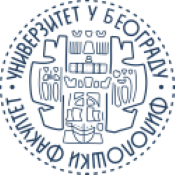Discourse Markers of Distancing
DOI:
https://doi.org/10.18485/beoiber.2018.2.1.4Abstract
Discourse research in the current Serbian studies is quite sidelined in comparison to Hispanic studies. From the onset of pragmatics in English and Hispanic studies, the discourse markers have received special attention. On this occasion we have chosen a small set of them, the markers of distancing or separation, which typologically belong to a wider group of reformulators. Our theoretical tools will rely on the contributions of the Philosophy of Language, the Theory of Relevance, Theory of Argumentation with its supporting theories of Topoi and Polyphony. Once we have established the terminology, definitions and classification, we will focus on contrastive analysis with the qualitative approach. Bearing in mind that the purpose of the markers is to guide the inferences in the communicative process, we will search for instructional equivalents for each of the reformulators of distancing with its similarities and divergences. The aim is first to determine the units in Serbian which correspond to those in Spanish and later to establish the conditions and the type of correspondence between them. The obtained results will shed light on the problem that arises from the difference between the quantifiers that belong to markers and that can affect the teaching and acquisition of both languages on the one hand, and the translation in both directions on the other.Key words: discourse marker, reformulation, distancing or separation, quantifier.References
Austin, John L. Cómo hacer cosas con palabras. Barcelona: Ediciones Paidos, 1990. Impreso.
Anscombre, Jean-Claude y Oswald Ducrot. La argumentación en la lengua. Madrid: Gredos, 1994 [1988]. Impreso.
Bazzanella, C. (ed.). Repetition in dialogue. Tübingen: Max Niemayer Verlag, 1996. Print.
Blakemore, Diane. Semantic constraints on relevance. Oxford: Blackwell, 1987. Print.
—. «The relevance of reformulations.» Language and Literature 2.2. (1993): 101–120. Print.
Briz, Antonio el al. (coords.). Diccionario de partículas discursivas del español. Web. 15 Oct. 2017.
Camacho Adarve, Mª Matilde. Análisis del discurso y repetición: plabras, actitudes y sentimientos. Madrid: Arco / Libros (Oralia, Anejos 5), 2009. Impreso.
Casado Velarde, Manuel. Introducción a la gramática del texto del español. Madrid: Arco / Libros, 2006. Impreso.
—. «Lingüística del texto y marcadores del discurso». M.ª Antonia Martín Zorraquino y Estrella Montolío Durán (coords.), Los marcadores del discurso. Teoría y análisis. Madrid: Arco / Libros. 2008: 55–70. Impreso.
Cortés, Luis y Mª Matilde Camacho. Unidades de segmentación y marcadores del discurso. Madrid: Arco / Libros, 2005. Impreso.
Cuenca, Mª Josep. Gramática del texto. Madrid: Arco / Libros, 2010. Impreso.
Charaudeau, Patrick y Dominique Maingueneau (dir.). Diccionario de análisis del discurso (DAD). Buenos Aires – Madrid: Amorrortu Editores, 2005. Impreso.
Ducrot, Oswald. El decir y lo dicho. Barcelona, Buenos Aires, México: Paidós, 1986. Impreso.
—. «Argumentación y 'topoi' argumentativos». Lenguaje en contexto 1 (1988): 63–84. Impreso.
Fraser, Bruce. «Pragmatic Markers». Pragmatics 6:2 (1996): 167–190. Print.
Fuentes Rodríguez, Catalina. La sintaxis de los relacionantes supraoracionales. Madrid: Arco / Libros, 1998. Impreso.
—. Diccionario de conectores y operadores del español (DCOE). Madrid: Arco / Libros, 2009. Impreso.
Gülich, Elizabeth y Thomas Kotschi. 1983. «Les marquers de reformulation paraphrastique». Cahiers de Linguistique Française, 5 (1983): 305–351. Imprimé.
Garcés Gómez, Mª Pilar. «La reformulación parafrástica en el discurso oral (español)». Luis Cortés Rodríguez et al. (eds.), Discurso y Oralidad. Homenaje al profesor José Jesús de Bustos Tovar. Madrid: Arco / Libros (Oralia, Anejos 3/2), 2007: 529–542. Impreso.
—. La organización del discurso: marcadores de ordenación y de reformulación. Madrid / Frankfurt am Main: Iberoamericana / Vervuert, 2008. Impreso.
Grice, Herbert Paul. «Utterer's Meaning and Intention». The Philosophical Review, 78/2 (1969): 147–177. Print.
Grice, Herbert Paul. «Logic and Conversation». Peter Cole, et al. Syntax and Semantics 3: Speech Acts (1975): 41–58. Print.
Martín Zorraquino, Mª Antonia y José Portolés Lázaro. «Los marcadores del discurso». Ignacio Bosque y Violeta Demonte (dirs.), Gramática Descriptiva de la Lengua Española, I–III. Madrid: Espasa-Calpe, 1999: 4051–4213. Impreso.
Matematički fakultet Univerziteta u Beogradu. Korpus savremenog srpskog jezika SrpKor2013. 2013. Web. 03–15 Oct. 2017.
Portolés, Jose. «El concepto de suficiencia argumentativa». Signo y seña, 9 (1998): 199–224. Impreso.
—. Marcadores del discurso, 4ª ed. Madrid: Ariel, 2011. Impreso.
Real Academia Española. Corpus de Referencia del Español Actual (CREA). 2008. Web. 05–15 Oct. 2017.
—. Diccionario de la lengua española (Actualización 2017), (DRAE). Madrid: Espasa. Web. 12–17 Oct. 2017.
Ristić, Stana. Modifikacija značenja i leksički modifikatori u srpskom jeziku. Beograd: Institut za srpski jezik SANU, 2009. Štampano.
Rodríguez Ramalle, Teresa Mª. «Los conectores entre la sintaxis, la semántica y la pragmática». CLAC 24 (2005): 74–90. Web. 16 Oct. 2017.
Sánchez López, C. «Los cuantificadores: clases de cuantificadores y estructuras cuantificativas». Ignacio Bosque y Violeta Demonte (dirs.), Gramática Descriptiva de la Lengua Española, I–III. Madrid: Espasa-Calpe, 1999: 1025–1128. Impreso.
Santos Río, Luis. Diccionario de partículas. Salamanca: Luso-Española de Ediciones, 2003. Impreso.
Sperber, Dan y Deirdre Wilson. Relevance. Communication and Cognition. Oxford: Basil Blackwell, 1986. Print.
—. «Relevance Theory». Larry Horn and Gregory Ward (eds.), The handbook of Pragmatics. Oxford: Blackwell, 2006: 607–632. Print.
Stevović, Igrutin. Funkcionalna gramatika srpskohrvatskog jezika. Sarajevo: Svjetlost, 1958. Štampano.
Velčić, Mirna. Uvod u lingvistiku teksta. Zagreb: Školska knjiga, 1987. Štampano.
Anscombre, Jean-Claude y Oswald Ducrot. La argumentación en la lengua. Madrid: Gredos, 1994 [1988]. Impreso.
Bazzanella, C. (ed.). Repetition in dialogue. Tübingen: Max Niemayer Verlag, 1996. Print.
Blakemore, Diane. Semantic constraints on relevance. Oxford: Blackwell, 1987. Print.
—. «The relevance of reformulations.» Language and Literature 2.2. (1993): 101–120. Print.
Briz, Antonio el al. (coords.). Diccionario de partículas discursivas del español. Web. 15 Oct. 2017.
Camacho Adarve, Mª Matilde. Análisis del discurso y repetición: plabras, actitudes y sentimientos. Madrid: Arco / Libros (Oralia, Anejos 5), 2009. Impreso.
Casado Velarde, Manuel. Introducción a la gramática del texto del español. Madrid: Arco / Libros, 2006. Impreso.
—. «Lingüística del texto y marcadores del discurso». M.ª Antonia Martín Zorraquino y Estrella Montolío Durán (coords.), Los marcadores del discurso. Teoría y análisis. Madrid: Arco / Libros. 2008: 55–70. Impreso.
Cortés, Luis y Mª Matilde Camacho. Unidades de segmentación y marcadores del discurso. Madrid: Arco / Libros, 2005. Impreso.
Cuenca, Mª Josep. Gramática del texto. Madrid: Arco / Libros, 2010. Impreso.
Charaudeau, Patrick y Dominique Maingueneau (dir.). Diccionario de análisis del discurso (DAD). Buenos Aires – Madrid: Amorrortu Editores, 2005. Impreso.
Ducrot, Oswald. El decir y lo dicho. Barcelona, Buenos Aires, México: Paidós, 1986. Impreso.
—. «Argumentación y 'topoi' argumentativos». Lenguaje en contexto 1 (1988): 63–84. Impreso.
Fraser, Bruce. «Pragmatic Markers». Pragmatics 6:2 (1996): 167–190. Print.
Fuentes Rodríguez, Catalina. La sintaxis de los relacionantes supraoracionales. Madrid: Arco / Libros, 1998. Impreso.
—. Diccionario de conectores y operadores del español (DCOE). Madrid: Arco / Libros, 2009. Impreso.
Gülich, Elizabeth y Thomas Kotschi. 1983. «Les marquers de reformulation paraphrastique». Cahiers de Linguistique Française, 5 (1983): 305–351. Imprimé.
Garcés Gómez, Mª Pilar. «La reformulación parafrástica en el discurso oral (español)». Luis Cortés Rodríguez et al. (eds.), Discurso y Oralidad. Homenaje al profesor José Jesús de Bustos Tovar. Madrid: Arco / Libros (Oralia, Anejos 3/2), 2007: 529–542. Impreso.
—. La organización del discurso: marcadores de ordenación y de reformulación. Madrid / Frankfurt am Main: Iberoamericana / Vervuert, 2008. Impreso.
Grice, Herbert Paul. «Utterer's Meaning and Intention». The Philosophical Review, 78/2 (1969): 147–177. Print.
Grice, Herbert Paul. «Logic and Conversation». Peter Cole, et al. Syntax and Semantics 3: Speech Acts (1975): 41–58. Print.
Martín Zorraquino, Mª Antonia y José Portolés Lázaro. «Los marcadores del discurso». Ignacio Bosque y Violeta Demonte (dirs.), Gramática Descriptiva de la Lengua Española, I–III. Madrid: Espasa-Calpe, 1999: 4051–4213. Impreso.
Matematički fakultet Univerziteta u Beogradu. Korpus savremenog srpskog jezika SrpKor2013. 2013. Web. 03–15 Oct. 2017.
Portolés, Jose. «El concepto de suficiencia argumentativa». Signo y seña, 9 (1998): 199–224. Impreso.
—. Marcadores del discurso, 4ª ed. Madrid: Ariel, 2011. Impreso.
Real Academia Española. Corpus de Referencia del Español Actual (CREA). 2008. Web. 05–15 Oct. 2017.
—. Diccionario de la lengua española (Actualización 2017), (DRAE). Madrid: Espasa. Web. 12–17 Oct. 2017.
Ristić, Stana. Modifikacija značenja i leksički modifikatori u srpskom jeziku. Beograd: Institut za srpski jezik SANU, 2009. Štampano.
Rodríguez Ramalle, Teresa Mª. «Los conectores entre la sintaxis, la semántica y la pragmática». CLAC 24 (2005): 74–90. Web. 16 Oct. 2017.
Sánchez López, C. «Los cuantificadores: clases de cuantificadores y estructuras cuantificativas». Ignacio Bosque y Violeta Demonte (dirs.), Gramática Descriptiva de la Lengua Española, I–III. Madrid: Espasa-Calpe, 1999: 1025–1128. Impreso.
Santos Río, Luis. Diccionario de partículas. Salamanca: Luso-Española de Ediciones, 2003. Impreso.
Sperber, Dan y Deirdre Wilson. Relevance. Communication and Cognition. Oxford: Basil Blackwell, 1986. Print.
—. «Relevance Theory». Larry Horn and Gregory Ward (eds.), The handbook of Pragmatics. Oxford: Blackwell, 2006: 607–632. Print.
Stevović, Igrutin. Funkcionalna gramatika srpskohrvatskog jezika. Sarajevo: Svjetlost, 1958. Štampano.
Velčić, Mirna. Uvod u lingvistiku teksta. Zagreb: Školska knjiga, 1987. Štampano.
Downloads
Published
2018-05-29
How to Cite
Bajić, D. “Discourse Markers of Distancing”. BEOIBERÍSTICA - Journal of Iberian, Latin American and Comparative Studies (ISSN: 2560-4163 Online), vol. 2, no. 1, May 2018, pp. 57-72, doi:10.18485/beoiber.2018.2.1.4.
Issue
Section
LINGUISTICS
License
Authors who publish with this journal agree to the following terms:
- Authors retain copyright and grant the journal right of first publication with the work simultaneously licensed under a Creative Commons Attribution-ShareAlike 4.0 International License that allows others to share the work with an acknowledgement of the work's authorship and initial publication in this journal.
- Authors are able to enter into separate, additional contractual arrangements for the non-exclusive distribution of the journal's published version of the work (e.g., post it to an institutional repository or publish it in a book), with an acknowledgement of its initial publication in this journal.
- Authors are permitted and encouraged to post their work online (e.g., in institutional repositories or on their website) prior to and during the submission process, as it can lead to productive exchanges, as well as earlier and greater citation of published work (See The Effect of Open Access).













